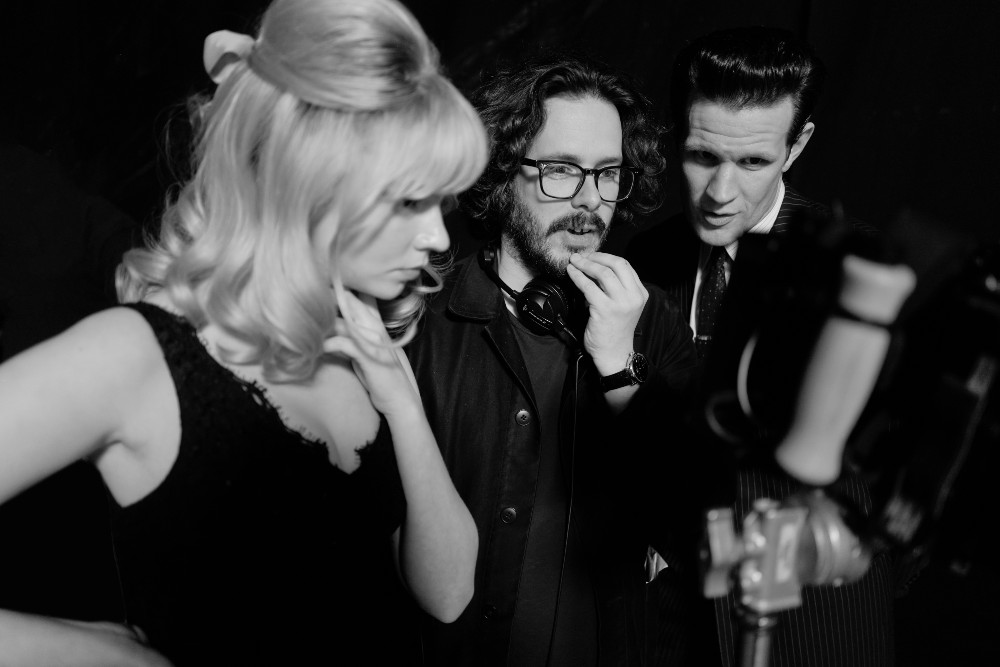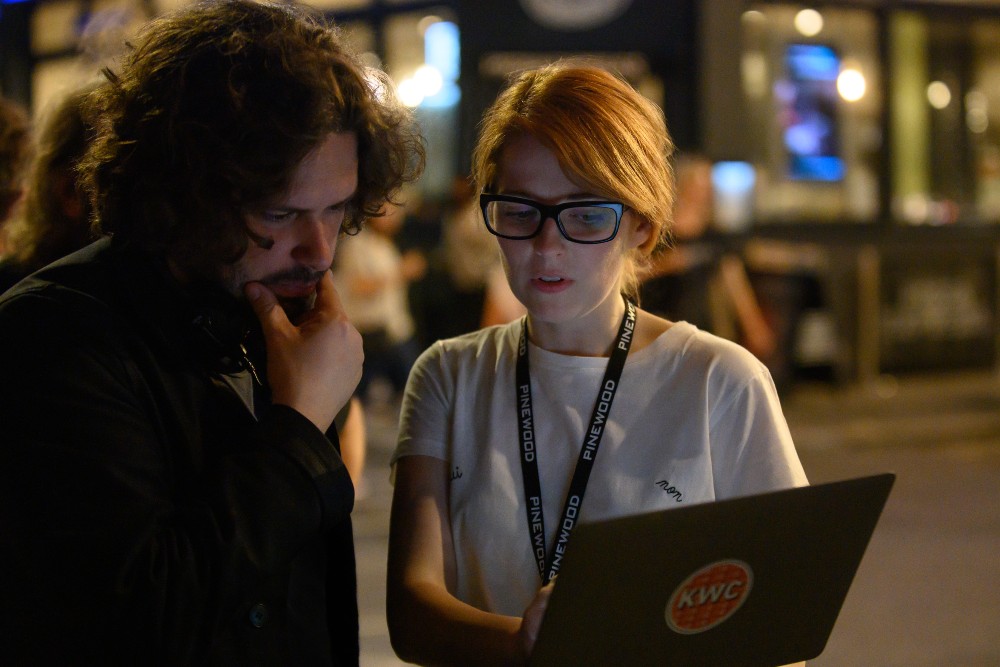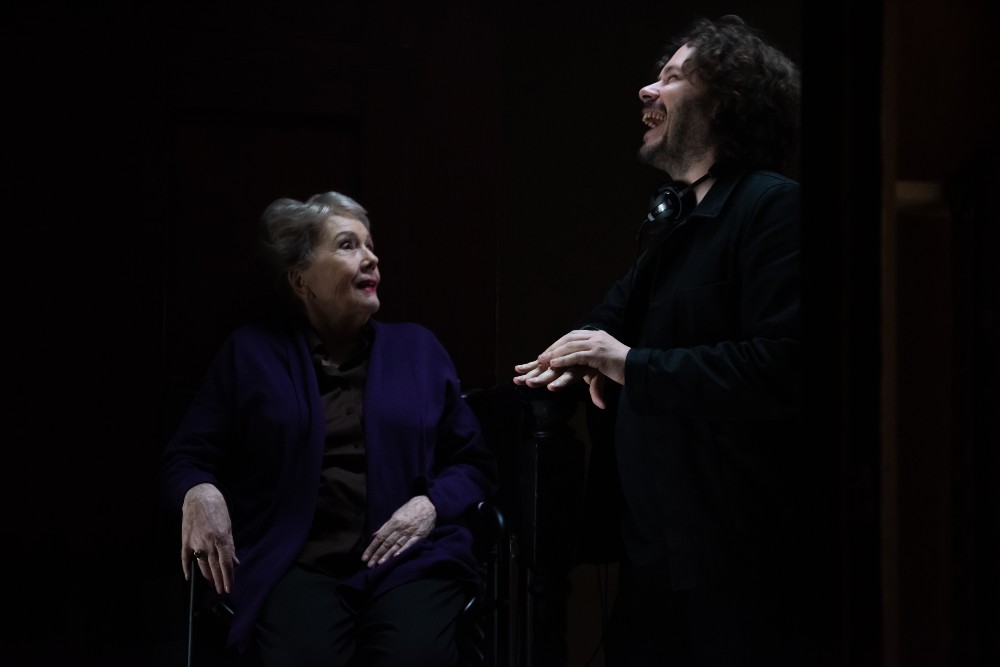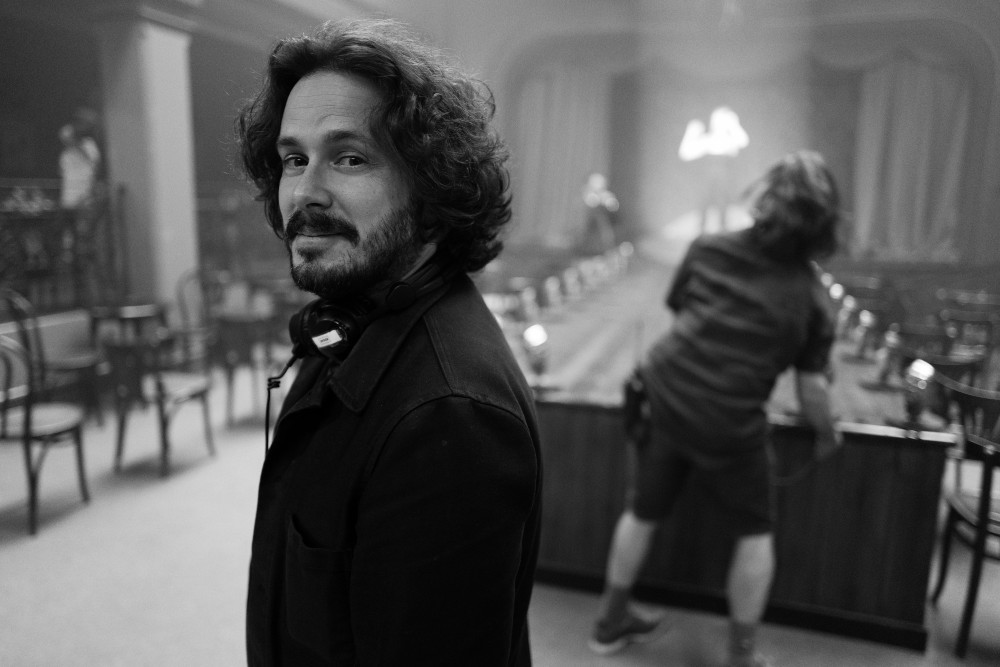
By now, filmmaker Edgar Wright probably needs little to no introduction, each of his films having built a fairly hearty audience of fans. With Last Night in Soho, Wright is doing something a little different, not because it’s a horror film — he’s had elements of that in all three movies he’s done with Simon Pegg and Nick Frost aka “The Three Flavours Cornetto Trilogy.”
No, this one is a horror film very much from a female perspective, and wisely, Wright brought on a co-writer in Krysty Wilson-Cairns, who wrote the screenplay for Sam Mendes’ amazing 2019 World War I film, 1917.
Together, they tell the story of an 18-year-old country lass named Eloise (played by Thomasin McKenzie from Jojo Rabbit) who comes to the big city of London in order to go to fashion school. Once there, she has trouble adjusting and fitting in, but she also has this knack for seeing the spirits of the dead. After moving into a rented room in a house run by a strict landlady (played by the late Dame Diana Rigg in her final performance), Eloise starts dreaming of a ‘60s show girl named Sandie (played by Anya Taylor-Joy), and she watches helplessly as Sandie gets thrust further into the seedy world of ‘60s Soho, unable to change her fate, since it took place 60 years earlier.
Although Last Night in Soho is different from many of Wright’s other films, there’s still a lot of things that remain the same. First of all, the film looks absolutely gorgeous, as Wright worked with the likes of Korean cinematographer Chung Hoon-chung, who shot many of Old Boy Director Park Chan-wook’s films.
But you can also feel the presence of Ms. WIlson-Cairns in all aspects of the storytelling, which still has maybe a smaller degree of humor than Wright’s other films, but it still finds a way to create the tension that existed in the ‘60s British thrillers that inspired Wright to make Last Night in Soho in the first place.
As you can tell from the banter between them, when Below the Line spoke to the filmmakers over Zoom earlier this week, Wright and Wilson-Cairns certainly had a lot to say about their experience making the movie together.
Below the Line: This is for Below the Line, and I think you can offer an interesting perspective, Krysty, since many of the cinematographers and production designers I speak to mention a film’s script as their reason for joining a project. You could offer some interesting insight into that from a writer’s perspective.
Krysty Wilson-Cairns: Yes, and once upon a time I was a runner, that’s where I started on set, so I’ve been in that world.
BTL: I saw Edgar doing a Q&A in Brooklyn, so I know how you two first met and the meetings that led to you joining Edgar on this, including the way you brought in some of your own life, such as The Toucan and living above a strip club. What was it about Edgar’s pitch that convinced you to get involved with this?
Wilson-Cairns: The first time Edgar actually told me the story, it was just as a friend, not as a collaborator, and I just remember having my socks kind of blown off by how fantastic, and unusual, and such a different story it was. I was just excited to hear it, and then when I actually got the call if I wanted to be involved in it, I’d already been thinking about it every single day. Soho had started to haunt you, so to be asked to do it was a very instant “Yes.”

BTL: The film looks amazing with so many collaborators from the cinematographer and the production designer. I did see Oscar’s credit in the movie, and I was interested in the transition from script to production design to being on set. Krysty, did you write a lot of the descriptions of things like Eloise’s room at the beginning? Was a lot of that from the script or something Oscar contributed?
Wright: What my brother Oscar does and has done on most of my movies is to do sort of concept designs, usually for the effects stuff. Oscar wouldn’t do concept designs for Eloise’s room. He used to do storyboards with me, but now, he doesn’t do that many storyboards — he sort of overseas the storyboard artists with me. He’s an incredible person to just have around, because I sometimes think me and my brother just have the same aesthetic sense. I always want to have him around, because I want to see what he thinks, and he’s a good problem solver as well. Some of the first things drawn for the movie — and he works with Marcus Rowland, my Production Designer as well — is that if there’s key images from the movie, almost like key frames, say like Eloise bursting through the glass to try and save Sandy. He’ll draw like a concept design of that, or some other parts of the end that I can’t go into. [laughs] It’s amazing looking back at them, because they’re almost the first images that we have. I’ve drawn a sketchy version of what I think it is, and then he embellished it. He didn’t do any storyboards for this one, but he did do one animatic, which I think will be on the Blu-ray, which is really good. It’s kind of amazing watching an animated version of one of the scenes.
In terms of everything else, that’s by Marcus Rowland’s amazing department. With the Eloise room, there were a couple of interesting things. We asked Thomasin to … [laughs] we didn’t ask Thomasin to dress [the room], but we definitely asked for her input in terms of, “Do you want to send any photos of your room, of how you would lay things out?” It was interesting how we took inspiration from Thomasin’s bedroom in New Zealand in terms of just how things were laid out. There’s sort of detail in that, because also, we want to get across in the first scene that if this 18-year-old girl is obsessed with a decade that is more than 50 years before her, what is the artwork on the walls? Even with that, there are some kind of tells in the movies, because the choice of the Breakfast at Tiffany’s poster and Sweet Charity is obviously quite pointed, because I think sometimes films like that — especially something like Breakfast at Tiffany’s where people maybe own the poster without necessarily having seen the movie. In that movie and the book has darker content than it might just appear from that image of Holly Golightly. Just such an iconic sort of poster image but actually, both Sweet Charity and Breakfast at Tiffany’s have a link to where Last Night in Soho is going. We still had a lot of fun putting those things together. The other thing I remember is that we had to get Twiggy, the real Twiggy, to sign off on her photo. So one of the many amazing things involved in this movie is me having an email conversation with Twiggy.
BTL: Krysty, is Oscar doing some of his drawings while you’re writing, so are you ever inspired by some of his artwork while writing?
Wilson-Cairns: Well, I mean, I was writing with Edgar, so we were always kind of in the room together, especially that first stage. I remember seeing some of your early sketches, and then seeing Oscar’s much-improved versions of them as well.
Wright: How dare you.
Wilson-Cairns: So sorry to tell the truth but…
Wright: You saw my scribble versions. I’d send Krysty a little sketch.
Wilson-Cairns: Yeah, just like a stick figure to explain shots and transitions, and also just action. And that’s fantastic to have those reference points. I mean, I really love working with Edgar, because he is such a visual director, and I like writing a very visual script. You get to really understand how the scenes are going to shape and build, and you combine that with music as well. It really is quite a unique and fascinating process, but having those images, especially when you go to do the redraft, and you’re tightening and you’re trying to work out, “Okay, what can we pull in?” Having those images and Marcus Rowland’s early concept stuff for that as well was really very eye-opening and useful.
BTL: You mentioned the music, and I’ve spoken with Edgar a lot about the music in his movies. Last Night has another amazing soundtrack, so were a lot of these songs included in the script while you were writing, and then you just worry about getting the rights later?
Wright: In a weird way, long before Krysty came on board, one of the ways that … I’d have the outline, but almost like memos to myself, like Post-it notes on the fridge, would be the songs. I sort of started slowly amassing the list of songs that were in a particular kind of tone that I thought was right for the movie. It was kind of narrowing in on a certain period, a certain emotion, and a lot of those in the film are all songs with great female singers at the time — Sandy Shaw, Cilla Black, Petula Clark, Dusty Springfield — and how emotional like they’re mini tear-stained operas. And then, in some cases I had even before writing the screenplay with Krysty, I had put certain songs with certain themes. Overall, it was the A-list of songs I’d like to use, and some had specific places and some did not.
But, when we were writing, I’d also sent Krysty this playlist saying, “Hey, this stuff will get you in the mood. This is the kind of thing I’m thinking.” And then, sometimes when we’d be writing, the obvious song would come up for a sequence. For example, there’s a showgirl sequence where Anya’s character is seemingly performing in this show under duress, or at least not happy about her role. As soon as that came up, I was like, “‘Puppet on a String,’ Sandy Shaw!” That song, famously, Sandy Shaw didn’t like it, didn’t want to record it, and it becomes her biggest hit. And then she’s cursed with having to perform it. Maybe she doesn’t perform it anymore, actually, but she was the one who liked the song the least. It just seemed like this is the obvious song for this bit.
But then, it was more sometimes like having these songs in reserve. So Krysty suggested — it wasn’t in the original outline — the audition scene, Krysty was the one who said, “I think you need one extra dream in the 60s before everything starts to go wrong.” And that’s where the audition scene came from. As soon as Krysty mentioned the idea of it, I just said, “She should sing Petula Clark’s ‘Downtown’.” It’s kind of this thing like where you’ve got this hit list, and at that point, we didn’t know… It’s funny. I was talking to Anya last night at the premiere. She said this, and I was trying to think about the leap of faith. She said, “You didn’t know I could sing before… ” Maybe I just asked you. I said, “Do you sing?” And you said, “Yes” but in that kind of slightly hesitant way, where you don’t know whether she means. Most actors, if you say, “Can you sing?” they’ll say “yes.” [laughs] But boy, could she sing, and her voice is amazing, so she said to me last night, “You didn’t know that I could sing when you asked me to sing in the movie.”And I said, “I think I had an inkling of it, but I didn’t know that you were gonna have this amazing knock-out voice.” When we heard her singing downtown, I think she went to record with Steve Price, and I wasn’t there. He went to sort of record with just her and pianist., and it was like a fast version and a slow version, and then doing it a capella as well. We listened to the a capella slow version, and it’s like, “That’s it! That’s what we’re doing. It’s amazing!”
BTL: When I talk to writers and especially writer/directors, I always wonder if when they’re writing something, how do you know you can pull it off? Krysty, you obviously have Edgar there, and you know he’s directed movies and can pull off anything, as well as Oscar’s drawings. But something like the Cafe de Paris scene where it’s switching between Thomasin and Anya, and it’s this amazing five or six-minute scene where you’re cutting between them, how do you know while writing that it will be possible?
Wright: What’s funny with that sequence is that it was written into the script, and I think the only thing that was written in and storyboarded was one transition. Interestingly, it was going to be in that moment that Thomasin swapped into Anya’s body, also was wearing the same costume and had the same hair. We’d spent a long time with [Costume Designer] Odile Dicks-Mireaux and [Hair and Makeup Stylist] Lizzie Georgiou getting Thomasin to look like Anya. The interesting thing is two things happened: we’d worked out this first transition, and then Jennifer White, the choreographer — as a back-up in a way — had done some extra ones. So she just sort of said, “Oh, and I’ve got some other options for some other kind of switches.” And I looked at it, and the thing is that you’re in a rehearsal room, because you have a video and you go in, you tend to just record it as one shot, because you’re not doing coverage when you’re in the audition room, you’re just recording the dancers. I was there looking at this thing watching these switches over and over again with a video camera in my hand, and I was thinking, “Why don’t we do them all? Let’s just make this a one-er where you keep doing it, so there’s like five in a row.” So it becomes really just a head rush and intoxicating. I think a lot of people think there are tons of edits in that shot, but there are not. It’s basically like an unbroken take.
The other interesting thing about that shot, and I was reminded of this when I watched a dress rehearsal. We did a dress rehearsal on set with the actors is right up until the end of it, Thomasin was gonna jump from her brown hair and pajamas into Anya’s costume and hair. I watched the dress rehearsal, and it was obvious to me that it was so slick, that maybe you wouldn’t notice the change between actresses. It was funny, because there was this earlier rehearsal done with Jen White and the two doubles, Adele and Madeline, who were a brunette and a blonde. We’d shot that with our same Steadicam operator, Chris Bain, and I’d shown that shot to my girlfriend, and there was one point where there was a switch between blonde and brunette. And she went, “Wait, wait, wait, wait, wait, wait, rewind that. What just happened?” And I stuck in my head [since] that was such a strong reaction, that then literally the day before we shot the shot, I said to the team, “You know what? I know we’ve got this wig, and we’ve got this costume for Thomasin, but she’s gonna stay in her like pajamas and brown hair.” Because otherwise, it might be so slick that people don’t even see what’s happening. It was such the right call to take away one part of hard work, but the end result is so much better for it. I had actually forgotten that it was like an 11th-hour change, but of course, it makes the scene.

BTL: I have two last questions. One that only Krysty can answer, and then one for Edgar, which I don’t think he’s ever been asked before. I know Edgar is very collaborative. I’m sure you were able to go to set and maybe be on set the whole time, but what was it like being on the set and seeing these scenes come to life?
Wilson-Cairns: I mean, it was both wonderful and also incredibly surreal. Because actually some of the places we shot… I mean, we shot in the bar that I used to work in when I was a starving artist, The Toucan. And actually, this arm is one of those scenes — not the face because I look straight down the camera and sweat profusely when we put me on TV. It was surreal. When you’re a writer, and you sit away and you invent these people in your head and how they sound and how it’s going to look. And even if it’s locations, you’re familiar with, you’re limited by what you can imagine. When you go onto a film set, it’s 300 odd people sharing their imagination to collaborate and to create something truly incredible, like truly astounding. It’s always such a privilege to go onto the sets that you write, because you realize that many heads are much better than one. And to watch Edgar get those performances and wrangle that slightly impossible thing. That thing you said earlier of like, “Oh, wonder if this is possible.” As a writer, it’s very easy, because anything you can put on the page, you’re like, “That’s their job now.” But working with Edgar, I never once was like, “I wonder if he’s gonna pull that off…” Now, I know maybe you felt differently sometimes on those four-hour night shoots where you’ve got a very, very tight window, but I always just sort of sat back and was like, “Oh, this is great. I just get to watch it be born.”
BTL: I didn’t think it was going to be like Charlie Kaufman’s Adaptation where you’re just wandering around set, and no one knows who you are, ‘cause Edgar gives a lot of props to his co-writers. Last question to Edgar: Shaun of the Dead is obviously a beloved movie that millions of people love, and it’s near perfect. It was also made very early in your career and probably with not as much money as you would get to make a movie now. If you were given $20 million and a chance to change anything, would you go back and do it, even if it’s just doing a Dolby Atmos mix for modern cinemas?
Wright: Ohhhhhh. [moderate pause] The one thing that I couldn’t do on that film, and listen, I’m not a big believer… I think, sometimes, when directors go back and fiddle with their old films, usually it’s bad news. There seems to be a lot of those things, and in most cases, there’s a very rare kind of occasion of a director going back to fix an old film and it actually being something worthwhile. I mean, many, many people still just want the original 1977 Star Wars. Thank you very much. I don’t need to see that 1997 Jabba the Hutt anymore. The one thing I wanted to do on Shaun and I couldn’t was that the Winchester was supposed to burn down. It’s even all set up — Nick Frost has a sort of a Molotov cocktail. I think we came to just such a budget crunch, where we needed to go over by two days, and the only way that we could pay for those two days was to cancel the fire insurance. So you can either have the fire or you can shoot for two more days, and I had to go for the latter. It was always a little bit to me … maybe I made up for it in this movie. [laughs] SPOILER ALERT! That was the one thing, but like, I wouldn’t go back and like do it. It would be pointless. There’s always something in every movie that I’ve done. There’s always something where I don’t think I have ever made a perfect movie, because there’s always something that I will see that I go, “If I could do it again, now I’d do that.” But I would never actually physically go back and do that. When I’m like 70 years old, and then the “Shaun of the Dead Coda: The Burning of the Winchester” suddenly exists…
Wilson-Cairns: We could just set fire to a pub one time. We can just do that, get it out of your system.
Wright: After so many years, that pub closed like a couple of years later. We probably could have burned down the real one.
We’ll leave Edgar and Krysty to their arson plans with hopes that they’ll instead make another movie together.
Last Night in Soho hits theaters nationwide on Friday, Oct. 29, but there are also previews on Thursday night. Tonight!
All photos courtesy Focus Features; Photographer: Parisa Taghizadeh.






